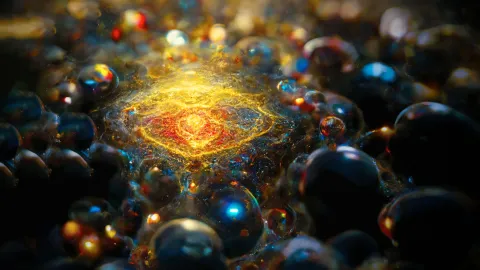Why the Multiverse is a “God-of-the-gaps” theory

- The Multiverse has been proposed as an answer to the question, “Why does our Universe exist?”
- Its proponents believe the Multiverse can explain our origins without having to reference God. But the Multiverse is in no way falsifiable, and the arguments in its support are nearly identical to the arguments for God.
- Not all questions need to be answered in order to be meaningful.
In the late 17th century, the German philosopher Gottfried Leibniz said, “The first question that should rightly be asked is, ‘Why is there something rather than nothing?’” Leibniz was turning to this question to prove the existence of God. His line of reasoning went like this:
1. Everything that exists has an explanation of its existence.
2. If the Universe has an explanation of its existence, that explanation is God.
3. The Universe exists.
4. Therefore, the explanation of the Universe’s existence is God.
By this logic, obviously, God exists. But the only obviously correct statement in Leibniz’s line of reasoning is number 3: The Universe exists. Number 1 is questionable, because “everything” is too strong a quality. Yes, we can explain clouds, and atoms, and rainbows, and the composition of Jupiter’s atmosphere, using materialistic arguments. But Leibniz is pushing this to include supernatural explanations as well. He is invoking the God-of-the-Gaps argument, where gaps in scientific knowledge serve as proof of God’s existence. In this case, since the Universe exists, and since science cannot explain the Universe, only God can explain the Universe. Therefore, God exists.
Sliding into cosmic inflation
The very success of the science that emerged during the 17th and 18th centuries — Newtonian mechanics and gravity, optics, chemistry, and so on — created a distance between science and religion. The trend continued with force for 300 years, and now most people accept a clear separation between the two. Religion may inspire a number of scientists, but it is no longer part of the scientific discourse.
That was true, at least, until the advent of the Multiverse hypothesis in recent cosmology.
The Multiverse is a strange idea. Its roots are very old, dating back to Ancient Greece. (The interested reader should consult Mary-Jane Rubenstein’s excellent book.) There are two main inspirations for the modern version of the Multiverse: Inflationary cosmology and superstring theory. In inflation, the Universe undergoes a super-fast, exponential expansion very early on in its infancy, fractions of a second after the Big Bang. The expansion is propelled at such speed by a hypothetical field called the inflaton — basically a fluid-like presence that permeates the whole of space and has the unique property of pushing space apart. A simple picture is that of a child going down a slide. Why does the child go down? Since she is not at the ground (the lowest point), there is potential gravitational energy that is converted into kinetic energy (motion) as the child slides. When the child hits the ground, all that potential energy has been converted to kinetic energy. At impact, that energy is converted into friction and heat.
The inflaton is similar. It starts with its potential energy, and while it is sliding down, this is converted into kinetic energy. But since the inflaton fills the whole of space, this process makes space expand like a balloon.
The Multiverse comes in when we add quantum physics to this picture. In quantum physics, everything is jittery. The inflaton is jittery, too. This means that while it is going downhill, quantum effects may kick it upward a bit in some regions of space, or down a bit in others. Since the amount of potential energy determines how fast the Universe expands, the inflaton will cause regions of space to expand faster or slower. The Universe splits into many Universes, each with its own expansion rate. This collection of Universes, or cosmoids, is the inflationary Multiverse. We live, supposedly, in one of these bubbles.
Landscaping the Multiverse
In superstring theories, the Multiverse comes from the string landscape. Briefly, superstring theories require spaces with six extra dimensions. This means superstrings live in nine-dimensional spaces. But we do not. At some point very early in the history of the Universe (or maybe before, it is not clear), six of these nine dimensions balled up and remained very tiny, while the other three — the ones we live in — kept growing. My PhD thesis, in the mid-1980s, was about different scenarios that would keep these extra dimensions small so that we cannot see them.
Now, this extra six-dimensional space has a shape, a topology. In fact, it can have many different topologies, and each one of them generates a different three-dimensional Universe. The theory predicts that the reason the Universe is the way it is — why the electron has the mass it does, why gravity or electromagnetism have the intensity they do — is due to the shape and topology of this extra six-dimensional space. We can picture the string landscape as the set of all possible shapes this extra space can have. Each generates a different three-dimensional Universe, with different physical properties. Ours, the theory states, would be the only one that has physical variables with the values we measure in the laboratory.
The superstring Multiverse, then, is the collection of all these Universes that pop up in the string landscape. And what does this have to do with God? Well, proponents of the theory argue that our Universe is fine-tuned for being the way it is and for having the properties it has. These properties include the existence of observers that can make theories about it. Some would argue this fine-tuning needs a fine-tuner, i.e., God. If you do not want a fine-tuning God, having a plethora of possible Universes reduces the problem to a kind of cosmic lottery game. Out of a huge number of Universes, ours is just one. We won the cosmic lottery, at least if you consider our existence to be a win — and we did not need a God to win it.
Familiar philosophical framing
How reasonable is this argument? First, from a physical perspective, we need to accept that superstring theory is a fundamental “theory of “everything,” including its predictions of supersymmetry — an extra symmetry of nature that predicts that each particle has a supersymmetric partner — and of six extra dimensions of space. So far, we have zero experimental evidence for either of these two properties. We have found no supersymmetry, and no extra dimensions. Proponents argue that maybe the supersymmetric particles are just too heavy to be seen by our current accelerators, while the extra dimensions are too tiny to be detected. Maybe, but then we cannot ever falsify this theory: Particles can always be too heavy and extra dimensions can always be too small for any machine that we ever build to detect.
The same with the Multiverse. By construction, these extra Universes exist outside our own and thus are not directly detectable. They may cause indirect signals, possibly from past collisions, but no such signal has been detected. On physical grounds there is not much support for the string landscape and its Multiverse.
And what about philosophically? The whole “if you don’t like God you’d better have the Multiverse” argument is very similar to Leibniz’s, just carried out backwards. This may be surprising for Multiverse enthusiasts to hear. But it should be clear that the Multiverse, in a curious inversion, is playing the exact same role as the God-of-the-Gaps. God’s existence is not provable by observations. The Multiverse is not provable by observations. God explains the Universe. The Multiverse explains the Universe. The Multiverse, then, is a lot like God. Weird, right?
The false assumption is that something that exists requires an explanation, whatever the cost of this explanation. In the case of the Universe, this is the problem of the First Cause, the uncaused cause that causes the Universe to become. This transition from being (God or an uncaused Multiverse) to becoming has been twisting our logical arguments into knots for at least 3,000 years, and probably longer. The question, then, is this: What is the price we must pay to have an “answer”? Is the price a supernatural cause, or an untestable scientific explanation? And in the end, does accepting either make a difference? Does it offer a way out? We should instead accept that not all questions need to be answered in order to be meaningful.





